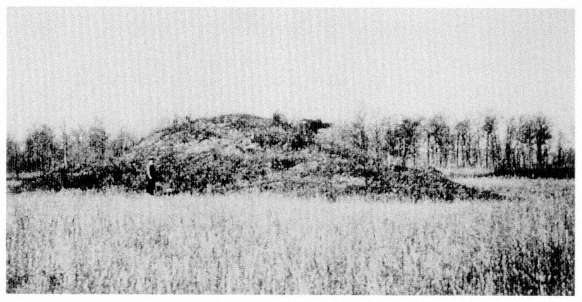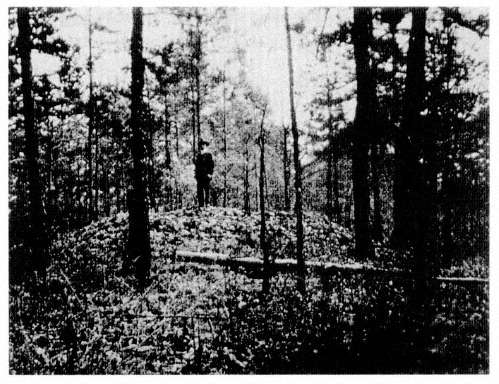Three
"Of Secret and Violent Blood"
The Indian Mounds of Yoknapatawpha
How similar yet how different the family and Confederate memorials were from the funereal monuments on the same landscape of an earlier time and people: the burial mounds of the Chickasaw Indians, who had inhabited the area for centuries. The Spanish explorer Hernando de Soto had found a flourishing Chickasaw civilization when, in 1541, he established his winter camp in the main Chickasaw town of Chicaca in what would become Pontotoc County. In the Treaty of Pontotoc (1832), under great pressure from the United States government and its restless white constituents, the roughly four thousand people of the Chickasaw nation had surrendered their ancestral lands and followed the "Trail of Tears" to the new Indian Territory in what would become Oklahoma. Unlike the neighboring Choctaws in central Mississippi, a third of whom elected to remain on small reservations there, the Chickasaws' removal was virtually complete. Though few, if any, "full-blooded" Chickasaws remained in Mississippi in Faulkner's lifetime, he allowed a few imagined remnants of the group to inhabit his writing. [1]
More lasting, however, in both history and fiction, were the burial mounds of Lafayette, Tippah, and Yoknapatawpha counties, emphatic constructions of bermed earth that would stand through the centuries to remind and rebuke (Figs. 12 and 13). Faulkner knew the several mounds around Oxford, and he owned an illustrated history of Mississippi archaeology that documented their presence throughout the state. In his partially autobiographical essay "Mississippi," he mused on the mounds in which the

Figure 12
Indian Mound, Lafayette County, Mississippi (photographed in 1913).

Figure 13
Indian Mound, Tippah County, Mississippi (photographed in 1918).
Native Americans would leave the skulls of their warriors and chiefs and babies and slain bears, and the shards of pots, and hammer- and arrow-heads and now and then a heavy silver Spanish spur .[2]
In the "Old Man" portion of The Wild Palms , in various sections from Go Down, Moses , and in numerous short stories, mounds appear as both subject and backdrop, as hauntingly mute but resonant monuments of, and to, their dispossessed builders. In the story "A Bear Hunt," five miles down the river from Major de Spain's camp, and in an even wilder part of the river's jungle of cane and gum and pin oak, there is an Indian mound. Aboriginal, it rises profoundly and darkly enigmatic, the only elevation of any kind in the wild, fiat jungle of river bottom . . . possessing inferences of secret and violent blood, of savage and sudden destruction, as though the yells and hatchets which we associated with Indians through the hidden and secret dime novels which we passed among ourselves were but trivial and momentary manifestations of what dark power still dwelled or lurked there, sinister, a little sardonic, like a dark and nameless beast lightly and lazily slumbering with bloody jaws—this, perhaps due to the fact that a remnant of a once powerful clan of the Chickasaw tribe still lived beside it under Government protection .[3]
As such, the mounds loomed on the landscape like the less hidden structures of the early white settlers—especially their great plain barns. While living among the Indians on the future site of Oxford in 1835, John J. Craig, John Chisholm, and John D. Martin negotiated with the Chickasaws the sale of two sections of land for making a town. As they began selling lots to other settlers, they donated fifty acres of public space that would constitute the square and the lots surrounding it. The county was named in honor of the French-born hero of the American Revolution, the Marquis de Lafayette, and the town, incorporated in 1837, was named for Oxford, the English university seat, in the hopes of attracting the state's primary institution of higher learning. In his fictive name for the town, Faulkner chose to honor another great figure from the Revolutionary era, Thomas Jefferson, but for the fictive county, significantly, he chose the name of an actual river in the southern part of Lafayette County, bearing the Chickasaw Indian name for slashed, or cut-opened land—Yoknapatawpha. [4]